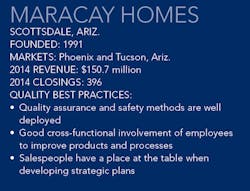Every morning at 8:28, Maracay Homes’ senior managers assemble in the War Room, a conference room for a standup meeting, no sitting allowed. Even managers in the field call in to participate in the 20-minute session to talk about priorities and activities for the day and about “stucks” (problems that need to be solved) and “delights” (good news about work or personal life).
Those managers then meet with their own teams for a huddle, which follows the same short, focused format. The daily gatherings are in addition to monthly all-company meetings, which are used to review key performance indicators for the business, and quarterly gatherings that provide an update on how the company is doing, focus on goals for the next 90 days, and recognize employees’ achievements over two hours of breakfast and socializing.
“When people first hear about our huddles, they say, ‘Gosh, that’s a whole bunch of mind-numbing meetings.’ But in reality, by creating this culture of communication, we actually decrease the need to call meetings that are usually called when something is going off the rails,” says Andy Warren, president of the Scottsdale, Ariz.-based builder, a member of the TRI Pointe Group.
On several occasions when Warren has attended every single company huddle within a couple of hours, he’s personally communicated with each of the builder’s 92 employees. The internal communication practice is a quick way to distribute information companywide and to gather employee feedback without having to go through the disruption of scheduling a big meeting in a central location.
The book Mastering the Rockefeller Habits inspired the practice. Its author, Verne Harnish, wrote that entrepreneurs of hyper-growth companies clearly communicate their vision and strategy so that each person knows what his or her role is. These companies have a “rhythm” or pattern of organized daily, weekly, monthly, quarterly, and annual meetings that are used to align priorities and drive accountability. Warren calls it Maracay’s cadence of meetings, where everyone is focused on what’s happening and what they must do to affect the desired result.
“One of our core competencies is around our people, and one of the things that we point to is frequent structured internal communication,” Warren says. “The idea is that we don’t want anyone at Maracay Homes to ever say, ‘No one ever tells me what’s going on around here,’ which is a common lament for people who work at companies where they feel like they’re in the dark.”
The builder’s employees—many of whom have come to the company via referrals from other Maracay staff—are hired after two to three months of multiple one-on-one interviews, a panel interview, background checks, and, finally, a sit-down with Warren. The arduous process ensures that the builder finds candidates who are self-starters with customer service skills. Maracay’s purpose, as mentioned in its one-page strategic plan, is to develop “a humble team that kicks ass.”
“We want our team to feel confident that they are ‘A’ players surrounded by other ‘A’ players who want to be in a culture where excellence is expected and they can thrive,” Warren says. “But we aren’t looking for super arrogant people either. If someone is so full of themselves ... then they’re not going to have that teachable spirit that will drive improvement. So there is this aspect of humility that we look for in the team, but we want people who are clearly confident to execute.”


